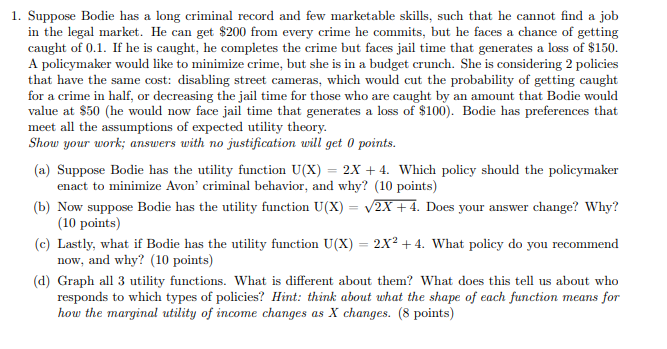
1. Suppose Bodie has a long criminal record and few marketable skills, such that he cannot find a job in the legal market. He can get $200 from every crime he commits, but he faces a chance of getting caught of 0.1. If he is caught, he completes the crime but faces jail time that generates a loss of $150. A policymaker would like to minimize crime, but she is in a budget crunch. She is considering 2 policies that have the same cost: disabling street cameras, which would cut the probability of getting caught for a crime in half, or decreasing the jail time for those who are caught by an amount that Bodie would value at $50 (he would now face jail time that generates a loss of $100). Bodie has preferences that meet all the assumptions of expected utility theory. Show your work; answers with no justification will get 0 points. (a) Suppose Bodie has the utility function U(X) 2X + 4. Which policy should the policymaker enact to minimize Avon' criminal behavior, and why? (10 points) (b) Now suppose Bodie has the utility function U(X) = 2X + 4. Does your answer change? Why? (10 points) (c) Lastly, what if Bodie has the utility function U(X) = 2X +4. What policy do you recommend now, and why? (10 points) (d) Graph all 3 utility functions. What is different about them? What does this tell us about who responds to which types of policies? Hint: think about what the shape of each function means for how the marginal utility of income changes as X changes. (8 points) V 1. Suppose Bodie has a long criminal record and few marketable skills, such that he cannot find a job in the legal market. He can get $200 from every crime he commits, but he faces a chance of getting caught of 0.1. If he is caught, he completes the crime but faces jail time that generates a loss of $150. A policymaker would like to minimize crime, but she is in a budget crunch. She is considering 2 policies that have the same cost: disabling street cameras, which would cut the probability of getting caught for a crime in half, or decreasing the jail time for those who are caught by an amount that Bodie would value at $50 (he would now face jail time that generates a loss of $100). Bodie has preferences that meet all the assumptions of expected utility theory. Show your work; answers with no justification will get 0 points. (a) Suppose Bodie has the utility function U(X) 2X + 4. Which policy should the policymaker enact to minimize Avon' criminal behavior, and why? (10 points) (b) Now suppose Bodie has the utility function U(X) = 2X + 4. Does your answer change? Why? (10 points) (c) Lastly, what if Bodie has the utility function U(X) = 2X +4. What policy do you recommend now, and why? (10 points) (d) Graph all 3 utility functions. What is different about them? What does this tell us about who responds to which types of policies? Hint: think about what the shape of each function means for how the marginal utility of income changes as X changes. (8 points) V







